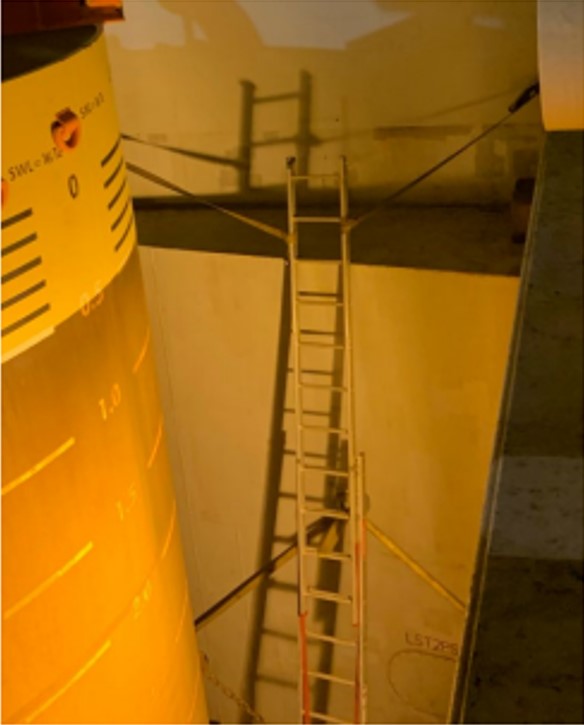Safety Alert: Fractured pelvis in a fall from a ladder
A crew person suffered a fractured pelvis falling 4-5 metres from a temporary access ladder onboard a cargo vessel. The ladder was installed as a workaround when the permanent cargo hold access / egress hatches were blocked.
The ladder was secured to a small access platform off the ‘tween deck by means of ratchet straps. The platform edge was 5 metres in height with no handrails or fall prevention and the ladder could only be accessed by stepping over the ratchet straps at the exposed edge. The casualty was aware that the ladder had been successfully used by other persons. Believing it to be safe, he started to descend. He was alone, it was raining heavily. The equipment and his working attire and PPE were wet. He slipped and fell backwards 4 metres to the deck below.
In pain he managed to climb up the ladder (the only way out of the hold) to seek assistance. He was taken to a local hospital. The injury required surgery to realign the pelvic bone by means of titanium screws and wires. The injured person needed at least three months to recover.
What went wrong
- Use of the ladder was not risk assessed and no working at height / fall protection mitigations were applied. There was no Management of Change applied when the ladder was installed. A work environment was created which influenced crew to use the ladder, creating a “routine violation”
- The casualty – a Rigging Supervisor – boarded the vessel at an interim mobilisation. There were no ISPS controls, inductions or familiarisations for visitors, who were not accompanied nor made aware of restricted areas on the vessel
- Stop Work Authority was not exercised – visitors accepted the different HSE standards of the sub-contractor and did not challenge non-compliance. All personnel boarding the vessel at the various mobilisations had the opportunity to challenge the unsafe ladder condition but did not
- Deck Drawings and review did not identify locations of access/egress hatches leading to them being blocked by mobilised equipment
Identified Root Causes
- Insufficient detail in Cargo Hold Drawing to create a safe load plan
- Design review did not assess safe cargo hold access/egress, stretcher routes and safe movement of personnel
- Failure to conduct verification activities and ensure compliance.
- Poor risk perception / culture in that personnel did not carry organisational expectations onto a subcontractor worksite
- Lack of basic operational control
Lessons and actions
- Thorough engagement with management of sub-contractor to align HSE expectations
- Ensure thorough review of sub-contractor safety arrangements, documents and compliance
- Review of the sub-contractor’s load plans
- Conduct verification activities to ensure a safe working environment and practices prior to starting work (focus on the nine Life Saving Rules and pre-start work checklists
- Ensure robust worksite supervision and empower personnel to exercise ‘Stop Work Authority’
- The ladder was removed from the vessel and safe access/egress was implemented
CLICK HERE FOR THE FULL REPORT
ICHCA International is committed to helping industry to learn lessons fast, learn them once and make sure that they stay learnt. This information is intended to provide all organisations in the cargo supply chain with the opportunity to consider the events and to review and adapt their own health and safety control measures to proactively prevent future incidents.
We are grateful to Dutch Safety Board for providing details and to the Nautical Institute for raising awareness. We acknowledge their commitment to sharing learning to benefit others. If you have similar operations, please share this information with managers, operatives and any potentially affected third parties as appropriate. Please also review any of your relevant operations for similar hazardous conditions, risks, and controls. Learning content like this is highly valuable as it is based on real-world experience. We encourage everyone with publishable information about incidents to send it to us, so that we can raise awareness across the whole industry. Please contact us at secretariat@ichca.com; sharing your insight could save a life or prevent injury.


